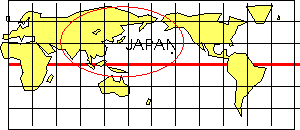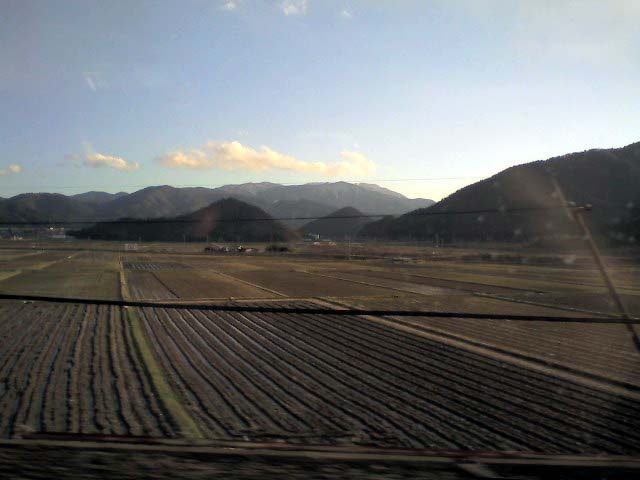 Climate influenced by the winds and oceans
The climate of Japan is heavily influenced by seasonal winds
brought on by Asian Monsoons. The summer winds are caused by
high air pressure systems over the Pacific Ocean. They bring
heavy precipitation on the areas facing the Pacific Ocean.
The winter winds caused by a Siberian high air pressure system
bring heavy snowfall on the areas facing the Sea of Japan.
The spring and autumn winds are brought on by extra-tropical
depressions which cause the very dramatic weather conditions
throughout Japan.
The cold winter winds and hot summer winds are made mild by
the surrounding sea temperatures and currents. Therefore,
the climate in Japan is not too tropical nor is it as cold
as Siberia.
Climate influenced by the distance of "Latitudes"
Because Japan is nearly 3000km long from north to south,
we experience a wide range of weather and climatic conditions.
For example, although Hokkaido and the northern parts of Japan
have heavy snowfall in January and February, on the other hand,
Okinawa, the southern most part of Japan has warm weather during
the same time of the year.
Okinawa has a subtropical climate which produces warm winters and
hot summers. Tropical flowers can be seen throughout the year, as
well as beautiful coral reefs that surround the islands.
On the other hand, Hokkaido is known for its dry and comfortable
summers and long icy winters. Locals as well as tourist are
attracted to its scenic beauty, which offers them the chance to
watch the drift ice on Sea of Okhotsk and participate in winter
sports like skiing and skating.
Climate described in a novel
The climate of Niigata, which faces the Sea of Japan, was
described in a very famous Japanese novel called gYukiguni
(Snow Country)h which was written by Yasunari Kawabata.
This famous novel even earned him the Nobel Prize for Literature.
In the first sentence from the book it says, gThe train came
out of the long tunnel into the snow country.h
This novel makes you understand that the train has traveled
from Tokyo to Niigata. These two cities are geographically very
close but the weather conditions are extremely different between
the two due to the high mountains that divide them. On a winter
day the weather in Tokyo will be very dry and sunny but in
Niigata it will be cloudy with heavy snowfall.
Climate transitions
The central part of Japan has four distinct seasons; winter,
spring, summer and fall. The summers are quite humid while the
winters are cold and dry. Spring and autumn are transition
periods between the other two seasons and can be quite moderate
in temperature. These transition periods between winter and
summer are not so obvious in the northern and southern parts
of Japan. See for "24 SEKKI."
"Tsuyu"
Japan's main rainy season is called "Tsuyu" in Japanese.
The stationary rain front, which is called "Baiu-zensen",
moves gradually from south to north. The rainy season begins
in early May in Okinawa. It does not reach Honshu until around
the 10th of June and ends around the 20th of July.
Needless to say an umbrella is very much needed during this
time. The gBaiu-zensenh dissipates in northern Japan before
reaching Hokkaido in late July. The beginning of this rainy
season is called "Tsuyu-iri" and is very important for rice
production.
Japanese rice field waiting for the Tsuyu-iri
coming around June.
Climate influenced by the winds and oceans
The climate of Japan is heavily influenced by seasonal winds
brought on by Asian Monsoons. The summer winds are caused by
high air pressure systems over the Pacific Ocean. They bring
heavy precipitation on the areas facing the Pacific Ocean.
The winter winds caused by a Siberian high air pressure system
bring heavy snowfall on the areas facing the Sea of Japan.
The spring and autumn winds are brought on by extra-tropical
depressions which cause the very dramatic weather conditions
throughout Japan.
The cold winter winds and hot summer winds are made mild by
the surrounding sea temperatures and currents. Therefore,
the climate in Japan is not too tropical nor is it as cold
as Siberia.
Climate influenced by the distance of "Latitudes"
Because Japan is nearly 3000km long from north to south,
we experience a wide range of weather and climatic conditions.
For example, although Hokkaido and the northern parts of Japan
have heavy snowfall in January and February, on the other hand,
Okinawa, the southern most part of Japan has warm weather during
the same time of the year.
Okinawa has a subtropical climate which produces warm winters and
hot summers. Tropical flowers can be seen throughout the year, as
well as beautiful coral reefs that surround the islands.
On the other hand, Hokkaido is known for its dry and comfortable
summers and long icy winters. Locals as well as tourist are
attracted to its scenic beauty, which offers them the chance to
watch the drift ice on Sea of Okhotsk and participate in winter
sports like skiing and skating.
Climate described in a novel
The climate of Niigata, which faces the Sea of Japan, was
described in a very famous Japanese novel called gYukiguni
(Snow Country)h which was written by Yasunari Kawabata.
This famous novel even earned him the Nobel Prize for Literature.
In the first sentence from the book it says, gThe train came
out of the long tunnel into the snow country.h
This novel makes you understand that the train has traveled
from Tokyo to Niigata. These two cities are geographically very
close but the weather conditions are extremely different between
the two due to the high mountains that divide them. On a winter
day the weather in Tokyo will be very dry and sunny but in
Niigata it will be cloudy with heavy snowfall.
Climate transitions
The central part of Japan has four distinct seasons; winter,
spring, summer and fall. The summers are quite humid while the
winters are cold and dry. Spring and autumn are transition
periods between the other two seasons and can be quite moderate
in temperature. These transition periods between winter and
summer are not so obvious in the northern and southern parts
of Japan. See for "24 SEKKI."
"Tsuyu"
Japan's main rainy season is called "Tsuyu" in Japanese.
The stationary rain front, which is called "Baiu-zensen",
moves gradually from south to north. The rainy season begins
in early May in Okinawa. It does not reach Honshu until around
the 10th of June and ends around the 20th of July.
Needless to say an umbrella is very much needed during this
time. The gBaiu-zensenh dissipates in northern Japan before
reaching Hokkaido in late July. The beginning of this rainy
season is called "Tsuyu-iri" and is very important for rice
production.
Japanese rice field waiting for the Tsuyu-iri
coming around June.
 The end of the season is called "Tsuyu-ake".
The Japan Meteorological Agency announces the end of "Rainy
season" every year. While Japanese people may welcome this
season they also dislike it very much due to the rain fall
that it produces.
"Typhoon"
After the end of the rainy season in late July, most Japanese
regions are exposed to scorching hot summer days. In this season,
it is not too uncommon for people to suffer from sunstrokes and
or heat strokes. During this time Japan is quite often hit by
typhoons. Typhoons are the equivalent of hurricanes and cyclones.
Hurricanes originate off the American coast and cyclones originate
off the Indian coast. Typhoons, however, form in the West Pacific.
Even though they are powerful and bring destruction to Japan,
most Japanese feel that the rain that is brought is a gift from
heaven. Good use is made of these powerful storms for rice
plantations and even a good deal of drinking water is produced
by these storms.
Previous Next
The end of the season is called "Tsuyu-ake".
The Japan Meteorological Agency announces the end of "Rainy
season" every year. While Japanese people may welcome this
season they also dislike it very much due to the rain fall
that it produces.
"Typhoon"
After the end of the rainy season in late July, most Japanese
regions are exposed to scorching hot summer days. In this season,
it is not too uncommon for people to suffer from sunstrokes and
or heat strokes. During this time Japan is quite often hit by
typhoons. Typhoons are the equivalent of hurricanes and cyclones.
Hurricanes originate off the American coast and cyclones originate
off the Indian coast. Typhoons, however, form in the West Pacific.
Even though they are powerful and bring destruction to Japan,
most Japanese feel that the rain that is brought is a gift from
heaven. Good use is made of these powerful storms for rice
plantations and even a good deal of drinking water is produced
by these storms.
Previous Next
Contact us